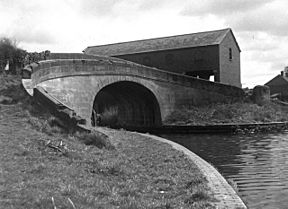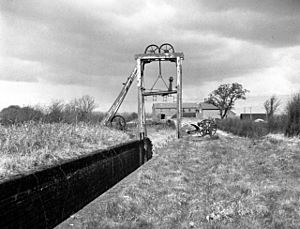Wappenshall Junction facts for kids
Wappenshall Junction is a special place where two canals met in Shropshire, England. It was built in 1835 when the Newport Branch Canal connected to the Shrewsbury Canal. This important meeting point for boats was closed down in 1944.
Contents
The Story of Wappenshall Junction
Building the Shrewsbury Canal
The Shrewsbury Canal got permission to be built in 1793. It was planned to run from the town of Shrewsbury to the Wombridge Canal. The canal company bought most of the Wombridge Canal. This helped them connect to the Donnington Wood Canal, where lots of coal was available.
The canal was flat from Shrewsbury to a place called Eyton, near Wappenshall. There were two locks there. South-east of Wappenshall, the canal went up through nine locks. Then, boats used an inclined plane at Trench. This helped them reach the Wombridge Canal, which was about 23 meters higher.
The canal opened in February 1797. It was built for small boats called tub-boats, which were about 2 meters wide. Most of the boats passing through Wappenshall carried coal towards Shrewsbury. Empty boats would travel back the other way.
Connecting to Other Canals
The Shrewsbury Canal was part of a group of canals in East Shropshire. For a long time, it was not connected to the main British canal system. In 1825, a new canal was approved, called the Birmingham and Liverpool Junction Canal. This canal would link the Ellesmere and Chester Canal to the Staffordshire and Worcestershire Canal.
Two years later, the Birmingham and Liverpool Junction Canal company thought about connecting their canal to the Shrewsbury Canal at Wappenshall. However, they had big problems building their main canal. So, nothing happened until 1831.
Henry Williams, who worked for both canal companies, looked into making the Shrewsbury Canal wider. This would allow bigger boats, about 2.1 meters wide, to use it. In the end, only two locks west of Wappenshall were made wider. Special boats were used on the Trench branch because of the narrower locks there. The new canal to Wappenshall Junction opened in 1835.
Changes and Closure
The Birmingham and Liverpool Junction Canal became part of the Shropshire Union Canal in 1846. This happened after it joined with the Ellesmere and Chester Canal. The Shropshire Union company soon bought most of the East Shropshire canals. They ran them well until the early 1900s.
However, after the First World War, the canals started to decline. The Trench inclined plane closed in 1921. Shrewsbury Basin closed in 1922. The canal, including Wappenshall Junction, was officially closed in 1944. This was done by an Act of Parliament from the London, Midland and Scottish Railway, who owned the canal at that time.
Restoring Wappenshall Junction
Today, Wappenshall Junction still has a warehouse built over part of the canal. There is also a roving bridge, which allowed horses to cross the canal without unhitching. The Shrewsbury & Newport Canals Trust has been working to restore this area.
Plans for the Future
In 2007, the old canal buildings at Wappenshall were put up for sale. These included a warehouse where goods were moved from boats. This warehouse hasn't changed much since the 1930s and still has many original parts.
Telford and Wrekin Council bought these buildings, along with a part of the canal and the Wappenshall basin. They are working with the Shrewsbury & Newport Canals Trust to fix the buildings. The goal is to create a museum and heritage center for the canal. There will also be a cafe and offices for the Canals Trust.
Important Buildings at the Junction
A towpath bridge crosses the link from Newport to Wappenshall. This bridge is still there and is a Grade II listed structure, meaning it's historically important.
Nearby is a three-story warehouse that sits right over a section of the canal. The first floor has trap doors. These allowed goods to be lifted from canal boats into the warehouse. This building is also listed. It was built by George Sutherland-Leveson-Gower, the Earl of Sutherland, not by the canal company.
The Sutherland Estate also built a nice office for the canal's toll clerk. This is a two-story red brick building. It has a central bay with three sets of windows. A small community grew around the junction. Several cottages and a pub called the Sutherland Arms were built nearby. The pub building is now called Bridge House.
On the way to Shrewsbury, a lift bridge crossed the canal just west of the junction. The Trench Branch, which goes south-east, passes under a small road at Wappenshall Bridge. Wappenshall Lock, the first of nine locks to Trench, was just after it.
Even though much of the basin has been filled in, there is still some water in the canal through the basin. A stream called Hurley Brook now flows into the canal below Britton Lock and leaves it again below Eyton Lock.



